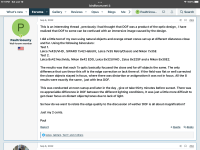Henry has a good point as to the difficulty of trying to quantify fuzziness, but like every valid point in all the threads about DOF, it ultimately goes nowhere because people just keep misusing the term itself. When I, knowing what "DOF" means as an optical term, fail to detect a difference between any binoculars of the same magnification that I've ever compared, there's no real need to resort to more precise techniques of measurement to see what I've missed; this is the expected result, and nothing remains to be explained. When others, apparently not knowing what "DOF" means, confidently state that one such model has dramatically more than another, we can be quite sure that they aren't merely being a bit sloppy in judging fuzziness, so more precise techniques won't help. They aren't trying to judge DOF at all, but considering something else and misappropriating the term.
Most likely they're evaluating an entire field that shows more or less curvature affecting what seems sharp, but recently we've also seen that something as simple as a slower focuser can give the impression of "less DOF" due to more focusing effort, which isn't even an optical effect at all, just faulty reasoning. Two related errors keep occurring: misunderstanding the precise definition of DOF, and failing to distinguish it from other effects. Sanity does indeed become an issue, because after having the relevant points explained yet again, the majority of posters just keep on saying the same thing. I don't think there's anything particularly murky or complicated or mysterious about this, and know of no cure. "When I use a word," Humpty Dumpty said in rather a scornful tone, "it means just what I choose it to mean -- neither more nor less."









